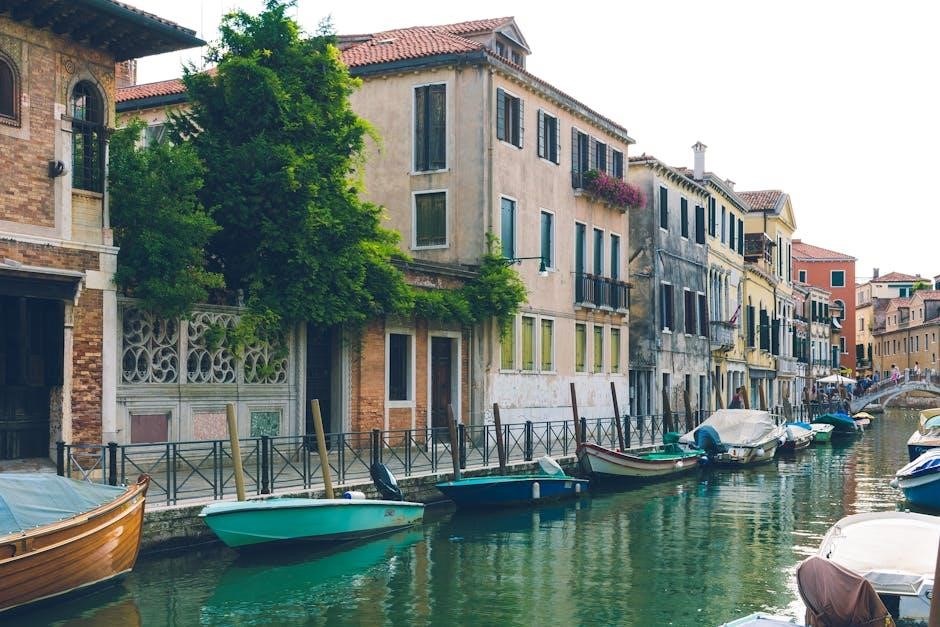Romeo and Juliet by William Shakespeare is a tragic love story set in Verona, Italy, revolving around the feud between the Montagues and Capulets. The tale of star-crossed lovers, Romeo and Juliet, explores themes of love, fate, and conflict, transcending generations as a timeless classic.
1.1 Overview of the Tragic Love Story
Romeo and Juliet, a tale of two young lovers from feuding families in Verona, explores the devastating consequences of their families’ hatred. The story begins with their instantaneous attraction at a Capulet ball, leading to a secret marriage facilitated by Friar Laurence. Their love becomes a beacon of hope to end the feud, but fate intervenes, culminating in their tragic deaths. The play delves into themes of love, loyalty, and the destructive nature of vendetta, leaving a lasting impact on literature and art.
1.2 Historical Context and Setting in Verona, Italy
Set in Renaissance-era Verona, Italy, Romeo and Juliet unfolds against a backdrop of bitter rivalry between two noble families, the Montagues and Capulets. The city’s picturesque setting contrasts with the violent feud, creating a dramatic tension. Verona’s streets and landmarks, such as the Capulet ball and the tomb, serve as key locations. The story’s historical context highlights the societal norms of the time, including arranged marriages and family loyalty, which shape the characters’ choices and the tragic outcome of their love story.

Main Characters and Their Roles
Romeo, a young Montague, and Juliet, a Capulet, are the star-crossed lovers whose doomed relationship drives the tragic narrative. Their families’ hatred fuels the conflict, while Friar Laurence, Tybalt, and Mercutio play pivotal roles in shaping their fate.
2.1 Romeo: The Montague Heir
Romeo, the Montague heir, is a passionate and sensitive 16-year-old. He falls deeply in love with Juliet at a Capulet ball, leading him to secretly marry her. His impulsive nature often drives the plot, as seen when he kills Tybalt in a duel, resulting in his banishment. Romeo’s tragic end, poisoning himself in Juliet’s tomb, underscores his loyalty and devotion to their love.
2.2 Juliet: The Capulet Daughter
Juliet, the 13-year-old daughter of Lord and Lady Capulet, evolves from an obedient child to a determined woman. Forced into an arranged marriage with Paris, she defies her family by secretly marrying Romeo. Her growth is evident as she devises a plan to fake her death to avoid the marriage, showcasing her courage and loyalty to Romeo. Ultimately, her tragic end in the tomb highlights her unwavering commitment to their love, making her one of Shakespeare’s most iconic female characters.
2.3 Key Supporting Characters (Friar Laurence, Tybalt, Mercutio)

Friar Laurence, a wise Franciscan friar, marries Romeo and Juliet to end the feud. His well-meaning plans ultimately lead to tragic consequences. Tybalt, Juliet’s cousin, is a hot-tempered Capulet who despises the Montagues, leading to Mercutio’s death. Mercutio, Romeo’s loyal friend, is witty and fiery, whose death at Tybalt’s hand sparks a chain of tragic events. Together, these characters drive the plot’s tension and emotional depth, shaping the play’s irreversible course.
The Feud Between Montagues and Capulets
The bitter, ancient feud between the Montagues and Capulets fuels the play’s tragic events. Originating from a forgotten grievance, their hatred escalates through pride and rivalry in Verona.
3.1 Origins of the Ancient Feud
The origins of the feud between the Montagues and Capulets are shrouded in mystery, with no one recalling its true beginnings. It likely stems from a forgotten grievance, possibly over power, land, or family honor. Over centuries, this grudge festers, evolving into a deep-seated hatred that defines Verona’s social landscape. The families’ animosity becomes so ingrained that even their servants harbor mutual contempt. This bitter rivalry sets the stage for the tragic events of the play, as the feud’s intensity endures despite its obscure origins.
3.2 Impact of the Feud on the Characters and Plot
The feud intensifies conflicts, driving the plot’s tragic trajectory. It fuels impulsive decisions, such as the duel between Mercutio and Tybalt, leading to Romeo’s banishment. The hatred forces Romeo and Juliet to conceal their love, heightening tension and desperation. Their families’ animosity isolates the lovers, making their situation hopeless. The feud’s pervasive influence shapes the characters’ emotions and actions, ultimately leading to the devastating conclusion. It underscores the destructive nature of unresolved conflict, a central theme of the play.

The Love Story and Marriage
Romeo and Juliet’s love begins at a Capulet ball, where they share a magical moment. They secretly marry with Friar Laurence’s help, hoping to end the feud.
4.1 Romeo and Juliet’s First Meeting at the Capulet Ball
Romeo attends the Capulet ball, where he encounters Juliet, and they fall deeply in love at first sight. Their families’ feud adds a dangerous layer to their romance.
4.2 Secret Marriage and Its Consequences
Romeo and Juliet marry in secret with Friar Laurence’s help, hoping to end their families’ feud. Their union intensifies the conflict, leading to Tybalt’s anger and Mercutio’s death, which results in Romeo’s banishment, further entangling their tragic fate.

Tragic Events and Climax
The fatal duel between Mercutio and Tybalt leads to Mercutio’s death, prompting Romeo to slay Tybalt and face banishment. Juliet’s fake death and the tomb tragedy follow.
5.1 The Fatal Duel Between Mercutio and Tybalt
The fatal duel occurs in Act 3, Scene 1, when Tybalt, Juliet’s cousin, seeks revenge against Romeo for attending the Capulet ball. Tybalt’s hatred for the Montagues fuels his aggression. Romeo refuses to fight Tybalt, but Mercutio, Romeo’s loyal friend, accepts the challenge. The duel ends tragically with Mercutio’s death at Tybalt’s hand. Enraged, Romeo kills Tybalt, leading to his banishment from Verona. This event escalates the families’ bitter feud and sets the stage for the play’s tragic conclusion.
5.2 Romeo’s Banishment and Juliet’s Fake Death
Following the duel, Romeo is banished from Verona for killing Tybalt. Juliet, desperate to avoid marrying Paris, turns to Friar Laurence for help. He provides her with a potion to feign death, hoping the plan will reunite her with Romeo. Juliet drinks the potion, and her family believes she is dead. Her fake death aims to escape her arranged marriage but ultimately leads to tragic misunderstandings, as Romeo does not learn of the ruse in time.

5.3 The Tragic Ending in the Tomb

Romeo, believing Juliet is dead, poisons himself in her tomb. Juliet awakens to find Romeo dead and, in grief, stabs herself with his dagger to join him in death. Their tragic end ultimately unites the feuding families, who realize the senselessness of their hatred. The lovers’ sacrifice brings peace, immortalizing their love as a legend of devotion and loss, forever remembered as a cautionary tale of fate and impulsive decisions.
Themes and Symbolism
Love vs. Hate and Fate vs. Free Will dominate the play, with light symbolizing love and darkness representing conflict. Fate’s inevitability drives the tragic outcome, highlighting human helplessness against destiny.
6.1 Love vs. Hate: Central Themes of the Play
The play explores the contrasting themes of love and hate, with Romeo and Juliet’s affection symbolizing hope amidst the feud between Montagues and Capulets. Their love transcends familial hatred, highlighting its redemptive power. Conversely, the deep-seated animosity between the families perpetuates violence and destruction. Shakespeare uses these opposing forces to illustrate how love can inspire compassion while hate leads to devastating consequences, shaping the play’s tragic trajectory and universal resonance.
6.2 Fate and Destiny in the Story
Fate and destiny are central to Romeo and Juliet, as the characters’ lives are shaped by forces beyond their control. From their first meeting to the tragic finale, fate orchestrates their journey. Romeo and Juliet believe their lives are predetermined, with Romeo often referring to his belief in fate. Their attempts to defy fate, such as Juliet’s fake death, ironically accelerate their doomed destiny. The play underscores the inevitability of fate, leaving the star-crossed lovers no escape from their destined tragedy, emphasizing the powerlessness of human will against cosmic design.
Adaptations and Legacy
Romeo and Juliet’s enduring appeal has led to countless adaptations, including films like Baz Luhrmann’s 1996 version and numerous stage productions. Its cultural impact inspires literature, music, and art globally.

7.1 Stage Productions and Film Adaptations
Romeo and Juliet has been adapted into numerous stage productions, with interpretations ranging from traditional to modern. Notable film versions include West Side Story (1961), a musical adaptation set in New York, and Baz Luhrmann’s 1996 version, featuring a modern setting with a star-studded cast. These adaptations highlight the timeless appeal of Shakespeare’s story, allowing audiences to connect with the narrative in fresh and innovative ways. The play’s versatility ensures its continued relevance across generations and cultures.
7.2 Cultural Impact of Romeo and Juliet
Romeo and Juliet has left an indelible mark on culture, inspiring countless adaptations, references, and interpretations. Its themes of love, fate, and conflict resonate universally, making it a timeless classic. The story has influenced literature, art, music, and film, with phrases like “star-crossed lovers” becoming part of everyday language. Its exploration of human emotions continues to captivate audiences, ensuring its legacy as one of the most enduring stories in history, transcending cultural and temporal boundaries.

